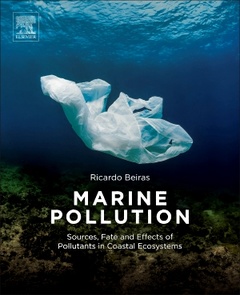Marine Pollution Sources, Fate and Effects of Pollutants in Coastal Ecosystems
Auteur : Beiras Ricardo

Marine Pollution: Sources, Fate and Effects of Pollutants in Coastal Ecosystems bring together the theoretical background on common and emerging marine pollutants and their effects on organisms (ecotoxicology). Written by a renowned expert in the field who is a researcher, teacher and advisor of national and international institutions on issues such as oil spills, water quality assessment and plastic pollution, this book offers a thorough account of the effects of pollutants on marine organisms, the relevant environmental regulations, and the public health implications, along with the biological tools advocated by the international institutions for marine pollution monitoring.Marine Pollution: Sources, Fate and Effects of Pollutants in Coastal Ecosystems presents information in a detailed and didactic manner, reviewing the latest scientific knowledge alongside examples of practical applications.
Part I. Pollutants in Marine Ecosystems1. Basic Concepts2. Nonpersistent Organic Pollution3. Nonpersistent Inorganic Pollution4. Microbial Pollution5. Liquid Wastes: From Self-purification to Waste Water Treatment6. Plastics and Other Solid Wastes7. Hydrocarbons and Oil Spills8. Persistent Organic Xenobiotics9. Trace Metals and Organometallic Compounds
Part II. Marine Ecotoxicology10. Distribution of Pollutants in Marine Environment11. Bioaccumulation12. Biotransformation13. Theory and Practice of Toxicology: Toxicity Testing14. Sublethal Toxicity at the Level of Organism15. Effects of Pollution on Populations, Communities, and Ecosystems
Part III. Monitoring and Abatement of Marine Pollution16. Biological Tools for Monitoring: Biomarkers and Bioassays17. Marine Pollution Monitoring Programs18. Pollution Control: Focus on Emissions19. Pollution Control: Focus on Receiving Waters
Primary: Undergraduates with a background in marine sciences, first year PHD students and early career researchers seeking a specialization in environmental management.
Secondary: students of environmental sciences (undergraduates and master students) seeking theoretical backgrounds and applied knowledge on state of the art marine pollution science.
Public and private stakeholders involved in the management of marine environment, specifically theoretical background and applied knowledge on pollution prevention, monitoring, effects and abatement.
- Provides an in-depth analysis of the uptake, accumulation and fate of pollutants in the marine compartments
- Delivers a critical appraisal on biological tools for the practical monitoring of marine pollution
- Presents key concepts and case studies to provide a comprehensive study of the different categories of marine pollution and its effects
Date de parution : 07-2018
Ouvrage de 408 p.
19x23.3 cm
Thèmes de Marine Pollution :
Mots-clés :
Marine pollution; Acetylcholinesterase; activated sludge; Acute toxicity; Amphipod; Antioxidant enzymes; Behavior; Benthic indices; Bioaccumulation; Bioassay; Bioavailability; Bioconcentration; Biodegradation; Biological Oxygen Demand (BOD)BOD5Chemical Oxygen Demand (COD)Hypoxia; Biomagnification; Biomarker; Biomonitor; Bioremediation; Biotransformation; Cadmium; Chemical pollution index; Clam reburial bioassay; Community structure; Copepod; Copper; Crassostrea; Cytochrome P450 monooxygenase (CYP)Glutathione (GSH)Metallothioneins; Depuration; Dioxins; Dissolved organic matter (DOM)Environmental half-life; Diversity; Dose response curves; Ecosystem services; Endocrine disrupting chemicals (EDC)Organobromines; Energy budget; Enrichment factor; Environmental quality criteria; EROD; Escherichia coli; Evenness; Fitness; Food web; Genotoxicity; GST; Hepatithis A; Humic acids; Hydrocarbons; Hypereutrophication; Indicator species; KOW; LC50Lowest observed effect concentration (LOEC)Mixture toxicity; Lead; Lipophilicity; Lysosomes; Mercury; Metal speciation; Methylmercury; Microalgae; Microbiological pollution; Microbiological quality of water; Microplastics; Molluscan shellfish safety; Municipal solid waste (MSW)Plastic additives; Mytilus; No observed effect concentration (NOEC)QSAR models; Norovirus; Oil spill; Oil; Organochlorines; PBT chemicals; Perfluorooctane sulfonate (PFOS)Personal care products; Pharmaceuticals; Physiological energetics; Plastic additives; Polybrominated diphenyl ether (PBDE)Polychlorinated biphenyl (PCB)Polycyclic aromatic hydrocarbon (PAH)Polymers; Reactive oxygen species (ROS)Salmonella; Scope for growth (SFG)Sea urchin; Self-purification; Sewage depuration; Sulfides; Toxicity; Tributyltin; Trophic level; Wastewater treatment plant (WWTP)


